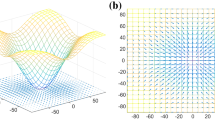Abstract
Three aspects of successful contouring with the computer are geologic interpretation, data, and the program or algorithm. All of these are important and must be considered jointly to combine good procedures with appropriate software, but interpretation is a critical requirement for mapping geologic variables. Several acceptable, though different, maps could be drawn with a given program and set of observations, so the map that best honors geologic concepts and interpretation is most desirable. Many computer-mapping projects are flawed because one of these three aspects is ignored.
This paper points out how data handling and choice of an algorithm should be affected by geologic knowledge and interpretation, including: (a) data consisting of mixtures of populations should be handled with special methods, (b) the algorithm should allow calculation of values beyond the range of observed values, (c) mapping thickness of a unit that pinches out requires projection to negative values and special handling of zero-thickness data, and (d) mapping structure on two related horizons requires that the surfaces be dealt with jointly.
Similar content being viewed by others
References
Bhattacharya, B. K., 1969, Bicubic Spline Interpolation as a Method for Treatment of Potential Field Data: Geophysics, v. 34, p. 402–423.
Briggs, I. C., 1974, Machine Contouring Using Minimum Curvature: Geophysics, v. 39, p. 39–48.
Davis, John C., 1986, Statistics and Data Analysis in Geology, 2nd Ed.: John Wiley & Sons, New York, 646 p.
Dubrule, Olivier, 1983, Two Methods with Different Objectives: Splines and Kriging: Math. Geol., v. 15, p. 245–257.
Dubrule, Olivier, 1984, Comparing Splines and Kriging: Comput. Geosci., v. 10, p. 327–338.
Fontaine, D. A., 1985, Mapping Techniques That Pay: Oil Gas J., v. 83, n. 12, p. 146–147.
Gonzalez-Casanova, P., and Alvarez, A., 1985, Splines in Geophysics: Geophysics, v. 50, p. 2831–2848.
Green, P. J., and Sibson, R., 1978, Computing Dirichlet Tesselations in the Plane: Comput. J., v. 21, p. 168–173.
Iglehart, Charles F., 1970, Descriptive Classification of Subsurface Correlative Tops: AAPG Bull., v. 54, p. 1697–1705.
Jones, Thomas A., and Johnson, Carlton R., 1983, Stratigraphic Relationships and Geologic History Depicted by Computer Mapping: AAPG Bull., v. 67, p. 1415–1421.
Jones, T. A., Hamilton, D. E., and Johnson, C. R., 1986, Contouring Geologic Surfaces with the Computer: Van Nostrand Reinhold, New York, 314 p.
McCullagh, M. J., and Ross, C. G., 1980, Delaunay Triangulation of a Random Data Set for Isarithmic Mapping: Cartographic J., v. 17, p. 93–99.
Peucker, T. K., 1980, The Impact of Different Mathematical Approaches to Contouring: Cartographics, v. 17, p. 73–95.
Philip, G. M., and Watson, D. F., 1982, A Precise Method for Determining Contoured Surfaces: J. Aust. Petrol. Explor. Assoc., v. 22, p. 205–212.
Rasmussen, K. L., and Sharma, P. V., 1979, Bicubic Spline Interpolation: A Quantitative Test of Accuracy and Efficiency: Geophys. Prospect., v. 27, p. 394–408.
Walters, Richard F., 1969, Contouring by Machine: A User's Guide: AAPG Bull., v. 53, p. 2324–2340.
Watson, D. F., 1981, Computing then-Dimensional Delaunay Tesselation with Application to Voronoi Polytopes: Comput. J., v. 24, p. 161–172.
Watson, D. F., 1982, ACORD: Automatic Contouring of Raw Data: Comput. Geosci., v. 8, p. 97–101.
Watson, D. F., and Philip, G. M., 1984, Triangle Based Interpolation: Math. Geol., v. 16, p. 779–795.
Watson, D. F., and Philip, G. M., 1987, Neighborhood-Based Interpolation: Geobyte, v. 2, p. 12–16.
Watson, G. S., 1984, Smoothing and Interpolation by Kriging with Splines: Math. Geol., v. 16, p. 601–615.
Author information
Authors and Affiliations
Rights and permissions
About this article
Cite this article
Jones, T.A. The three faces of geological computer contouring. Math Geol 21, 271–283 (1989). https://doi.org/10.1007/BF00893690
Received:
Accepted:
Issue Date:
DOI: https://doi.org/10.1007/BF00893690




